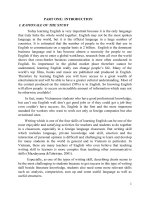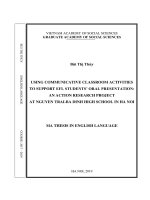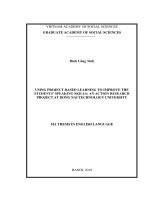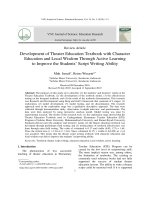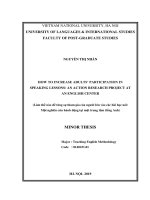Using project-based learning to improve the students’ speaking skills: an action research project at Dong Nai Technology University
Bạn đang xem bản rút gọn của tài liệu. Xem và tải ngay bản đầy đủ của tài liệu tại đây (1.09 MB, 113 trang )
VIETNAM ACADEMY OF SOCIAL SCIENCES
GRADUATE ACADEMY OF SOCIAL SCIENCES
Đinh Công Tính
USING PROJECT-BASED LEARNING TO IMPROVE THE
STUDENTS’ SPEAKING SKILLS: AN ACTION RESEARCH
PROJECT AT DONG NAI TECHNOLOGY UNIVERSITY
MA THESIS IN ENGLISH LANGUAGE
HANOI, 2019
VIETNAM ACADEMY OF SOCIAL SCIENCES
GRADUATE ACADEMY OF SOCIAL SCIENCES
Đinh Công Tính
USING PROJECT-BASED LEARNING TO IMPROVE THE
STUDENTS’ SPEAKING SKILLS: AN ACTION RESEARCH
PROJECT AT DONG NAI TECHNOLOGY UNIVERSITY
Field: English Language
Code: 8220201
Supervisor: Phạm Hữu Đức, Ph.D.
HANOI, 2019
DECLARATION BY AUTHOR
I, the undersigned, hereby certify that the thesis entitled “Using
Project-Based Learning to Improve The Students’ Speaking Skills: An Action
Research Project at Dong Nai Technology University” is the result of my
own research for the Degree of Master of Arts in English Language. The
substance of the thesis has not, wholly or in part, been submitted for any other
degree to any other universities or institutions.
Except where reference has been made in the text, this thesis contains
no material previously published or written by another person.
The study reported in this thesis was approved by Graduate Academy
of Social Sciences.
Author’s Signature
Đinh Công Tính
Approved by
SUPERVISOR
Phạm Hữu Đức, Ph.D.
Date: …………………………..
i
ACKNOWLEGDEMENTS
Although only one name appears as the author of this work, writing a
thesis is indeed a collaborative effort. I would like to express my sincere
thanks to the many people who made it possible.
First and foremost, I would like to express my heartfelt gratitude to my
M.A thesis’s supervisor, Phạm Hữu Đức, Ph. D. for his kind consultation,
invaluable encouragement as well as thorough correction in the process of
completion. But for his helpful guidance, this study would not have been
achieved.
Next, I would like to convey my sincere appreciation and thanks to Mr.
Đặng Nguyên Giang - Dean of the Department of Foreign Languages and the
other staff at Graduate Academy of Social Sciences the Department of
Foreign Languages, Graduate Academy of Social Sciences for granting me
the honor of writing this thesis as well as their assistance and most valuable
comments.
Especially, millions of my special thanks go to the lecturers and
students at Dong Nai Technology University who participated in this study for
their kind and patient co-operation and encouragement. They helped provide
me with valuable data for the study so that I could have a better view of
activities in English speaking classes at Dong Nai Technology University in
Bien Hoa city, Dong Nai Province.
Last but not least, I am deeply indebted to my family for their sympathy
and support during all the time I was studying for M.A degree at Graduate
Academy of Social Sciences. Without their unconditional love and sincere
contribution, I could not have overcome my difficulties and concentrated on
my studies.
ii
TABLE OF CONTENTS
Page
DECLARATION BY AUTHOR
i
ACKNOWLEDGEMENTS
ii
ABSTRACT
vi
LIST OF TABLES
vii
LIST OF FIGURES & CHARTS
viii
LIST OF ABBREVIATIONS
ix
CHAPTER 1: INTRODUCTION
1
1.1. Rationale
1
1.2. Aims of the Study
3
1.3. Research Questions
3
1.4. Scope of the Study
3
1.5. Significance of the Study
4
1.6. Research Methods
5
1.7. Structure of the Study
6
CHAPTER 2: LITERATURE REVIEW
8
2.1. Concepts of speaking
8
2.1.1. Definitions of speaking
9
2.1.2. Characteristics of speaking
12
2.1.3. Functions of speaking
13
2.1.4. The importance of teaching speaking
13
2.1.5. Principles of teaching speaking
15
2.1.6. Teacher’s roles in teaching speaking
17
2.1.7. Components of teaching speaking
18
2.2. Communicative Language Teaching
21
iii
2.3. Project-based learning
23
2.3.1 Definitions of project-based learning
23
2.3.2. Types of projects
26
2.3.3. Key features of Project-based learning
26
2.3.4. Advantages and challenges of project-based learning
29
2.3.5. Process of Project-based learning
31
2.4. Previous studies
33
2.5. Summary
36
CHAPTER 3: METHODOLOGY
37
3.1. Research Setting
37
3.2. Participants
38
3.3. Data Collection Instruments
40
3.4. Research design
44
3.5. Research Procedures
49
3.5.1. Phase 1: Planning
49
3.5.2. Phase 2: Action
50
3.5.3. Phase 3: Observation
52
3.5.4. Phase 4: Reflection
53
3.6. Data Analysis
55
3.7. Summary
56
CHAPTER 4: FINDINGS AND DISCUSSIONS
57
4.1. Data Analysis from Tests
57
4.2. Data Analysis from Questionnaires
60
4.3. Data Analysis from Interviews
73
4.4. Summary
75
CHAPTER 5: CONCLUSION
76
iv
5.1. Recapitulation
76
5.2. Concluding Remarks
77
5.3. Implications
79
5.4. Limitations and Suggestions for Further Studies
81
REFERENCES
83
APPENDIX 1: Pre-test for students
I
APPENDIX 2: Survey questionnaire
II
APPENDIX 3: Post-test for students
IV
APPENDIX 4: Scoring Rubric for Speaking test
V
APPENDIX 5: English Speaking Ability Evaluation
VII
APPENDIX 6: Interview questions
VIII
APPENDIX 7: Post-trying out questionnaire
IX
APPENDIX 8: Sample lesson plan
XI
v
ABSTRACT
Nowadays, English becomes more and more important in almost
aspects of life. English is a global language, so it is a compulsory subject at
schools and universities. Communication is one of the most important skills
in study, and work. Being a lecturer at a university, I recognize that we should
help our students find the better way to improve their speaking skills and feel
confident when talking or speaking in front of the class or the crowded or
making a conversation with foreigners. After learning about some methods to
help the students improve their speaking skills. We chose Project – based
Learning to apply for our speaking classes in experiment. After doing this
experiment, we found out two issues: (1) the students’ attitudes to using
Project – based Learning in speaking classes; (2) the result of students in
Speaking classes when applying Project – based Learning. I randomly chose a
Class with class code 0070133 to carry out my action research project with
the participants: 30 the first-year students a Dong Nai Technology University.
We performed this study in 12 weeks and used questionnaires, pre- test, posttest and interviews for collecting data instruments. The research findings us
that the students has positive attitudes to using Project – based learning in
speaking classes and PBL was a good way to help students improve their
speaking skills. With the result we got in the findings, both the lecturers and
the students could find the own way for teaching and learning to achieve the
best result in speaking skills in speaking classes.
vi
LIST OF TABLES
Page
Table 1: Assessing Speaking Performance- Level B1 (CEFR)
14
Table 2: Observation checklist
53
Table 3: Procedures of the study
54
Table 4: A comparison of Mean Score on Pre-Test and Post-Test
58
by Three Raters
Table 5: Mean score of tests
59
Table 6: Changes after taking part in the lessons using PBL
71
vii
LIST OF FIGURES & CHARTS
Page
Figure 1: Action Research Cycle
49
Chart 1: Students’ opinions of being afraid of speaking English in
62
class
Chart 2: Students’ frequency of speaking English
63
Chart 3: Students’ difficulties of speaking English in class time
64
Chart 4: Frequency of practicing speaking English in class
65
Chart 5: The active activities of students in teamwork in English
66
speaking lessons
Chart 6: Students’ interest in English speaking activities
67
Chart 7: Students’ opinion of using project-based learning in
68
optional lessons
Chart 8: Students’ opinions about the effectiveness of project-
70
based learning in improving speaking skills
Chart 9: Students’ improvement for criteria after applying project-
71
based learning in improving speaking skills.
Chart 10: The students’ difficulties when carrying out the project
for the first time
viii
73
LIST OF ABBREVIATIONS
AR:
Action Research
CEFR:
Common European Framework for Reference
CLT:
Communicative Language Teaching
DNTU:
Dong Nai Technology University
EFL:
English as Foreign Language
PBL:
Project-Based Learning
Ss
Students
ix
CHAPTER 1: INTRODUCTION
1.1. Rationale
Nowadays, with the development of science, technology, education and
economy, English becomes more and more important in our modern society.
We have to use English in almost every aspect of life and in almost fields of
work and study. So English becomes a compulsory subject in primary
schools, secondary schools, high schools, especially in universities throughout
the country in Vietnam. In almost universities, students learn English as a
compulsory subject. They learn listening skill, speaking skill, reading skill
and writing skill. And one of skills which students lack the confidence when
practicing is speaking skill. After twelve years studying at school, they just
focused on grammar and reading comprehension to pass the college entrance
exam, they did have lots of chances for practicing speaking. They often lack
of confidence in communication. On the other hand, Dong Nai Technology
University’ outcomes require that the students must speak English well and
have enough ability to pass the English interview for trial job interview. One
of the reasons leading them to this problem is they lack time and method for
learning speaking. Being acknowledged, speaking is one of the most
important skills in our modern society, especially at work. Moreover, after
teaching for a long time at the University, the speaking abilities of the thirdyear and final-year students were supposed to be not good. So we should help
the first-year student improve their speaking skills to gain the better speaking
abilities in the future, especially when they graduate and apply for work. In
each lesson, we should make many different activities so that students have
lots of chances to speak English and have an assignment to do as a mini
project. To do the mini project, the students have to make a group and divide
the task become smaller parts to do. In each group, the students have to share
1
the assignment to do. Each student takes a task, and the leader collects the
data and material to make the perfect project. During doing the project, they
have the chances to explore the real world, cooperate with their partners,
practice searching information, analyze data, prepare and practice speaking
for the presentation.
The latest years, Project-based learning (PBL) has been strongly
promoted and applied in teaching speaking skills in universities to help the
students improve their abilities. PBL makes the students spend more time on
using some tools to complete their English assignment. It creates an
environment for studying and learning professionally. The students feel very
eager to come to class each day when they have English lesson. Moreover,
PBL is believed that it will help student feel passionate about learning
English,
especially
speaking
skills
and
feel
confidents
in
daily
communication, also at work because they have chances to practice in group
task and experience in real life.
Having been teaching English at a university for many years and
recognizing the main causes for the problem – lack of confidence of students
in speaking skills, and the researcher is also motivated by the new approach
PBL for teaching speaking skills. The research really desires that the students
can have more opportunities to search, study and practice. Also, they can find
out that PBL is one of the best ways to help them improve their English day
by day. With above reasons, the researcher really aspires to conduct a study
on “Using project-based learning to improve the students’ speaking skills:
an action research project at Dong Nai Technology University” to find the
better way for the teaching and learning English speaking skills and apply
suitable techniques and activities in speaking class. With the hope, the
students can improve their ability for speaking skills. This study with the
2
objective is to explore the application of the project-based approach to
improve speaking skills for the first-year students at Dong Nai Technology
University.
1.2. Aims of the Study
There are many reasons to conduct this study, and one of the majority
aims of this study is to improve the first-year students’ English speaking skills
at Dong Nai Technology University. To gain the aim, the researcher must to
reach the following objectives as:
- Learning about the students’ attitudes to Project – based learning applied
in speaking classes whether it is positive.
- Finding out the advantages of project – based learning for the students in
speaking skills when it is applied in speaking classes.
1.3.
Research Questions
To achieve the above aims of the study, the researcher must find out the
answers to the following research questions:
1. What is the first-year students’ attitude to project-based learning at
Dong Nai Technology University in speaking lessons?
2. What do the first-year students gain from applying project-based
learning in speaking skills?
1.4.
Scope of the Study
Studying English language is very large. We have many aspects to do
the research. So this study cannot cover all skills in teaching English. We only
divide into smaller parts in the skill which we chose to do the research. And in
this study, the researcher only focuses on using Project-based Learning to
help the students at Dong Nai Technology University improve their English
speaking skills. This research only focuses on some typical skills used in
3
project-based learning which could improve the students’ speaking ability and
help them feel confident in communication.
In this study, the main subject is the thirty male and female students in
English class with class code 0070133. They are the first-year students, and
they are non-majored English students. The average age of the students is
around 19. They are going to be the main subject to participate in and respond
to the survey questionnaires, the trial lessons and the tests.
The action plan is going to last in 3 months from early March 2019 to
late May 2019, in third semester of the academic school year 2018-2019
Dong Nai Technology University.
1.5.
Significance of the Study
English communication is really important in almost aspects of life,
especially in education and economy. Hopefully, the study will contribute into
the success of teaching speaking skills at schools in general and at Dong Nai
Technology University in particular.
This study has an important significance to Dong Nai Technology
University, especially to the students and lecturers at there. Theoretically, the
findings of this research will prove the effectiveness of Project-based learning
in previous studies. With the hope, after this study, both students and lectures
at Dong Nai Technology University could find out the best way for studying
and teaching Speaking Skills. Besides, the findings of this research can be a
reference for teaching speaking skills to other researchers who want to study
PBL more intensively in the future.
This study is really significant to the researcher because the researcher
desires that this study will find out the benefits in teaching and learning
speaking skills to the teachers and students at Dong Nai Technology
University. The first thing, after doing this research, the researcher will master
4
the theory, technique and have much knowledge after learning other
researches for this field. The researcher will know how to motivate the
students join in speaking activities and make them feel confident and excited
about speaking tasks by using PBL effectively.
The second thing, the research hopes that after carrying out this study,
the findings can support the other lecturers of Faculty of English Language at
Dong Nai Technology University in using PBL in teaching and learning
speaking activities. They can combine the traditional teaching methods and
PBL to make the students interested in speaking lessons. They can make
speaking activities become various and the students have lots of chances to
practice speaking skills and experience in good speaking environment. The
third thing, this has a very important significance to the students. Hoping with
the positive results of this research, the students will become eager and
interested in speaking lessons. They will have more passions for English,
especially for speaking skills. Then they can improve their English speaking
skills with PBL day by day. And someday, they will be good at speaking
skills and daily conversation. The last thing, to Dong Nai Technology
University, the principle can base on the result of this study to recommend the
other English lecturers to refer to PBL in using the appropriate techniques and
strategies in teaching speaking skills and other activities concerning about
communication. So the lectures will feel confident and have many useful
teaching methods to help the students improve their speaking ability to bring
the success to students and the university.
1.6.
Research Methods
In this study, the researcher desires to find out the positive result after
applying PBL in speaking lessons. To do this, during teaching period, the
research must conduct many activities to perform this study. One of the best
5
methods for this study is an action research in the classroom. Action research
is really a useful tool to help the research combine the reflective thinking by
observation and then improve my teaching methods by actions by collecting
and analyzing data. In the case of this study, the main objective is to identify
the students’ attitude to applying PBL in speaking lessons and evaluate the
effectiveness of this method in improving student’s speaking ability. So
action research is the best choice for this study.
In this study, the researcher uses both qualitative and quantitative
methods to gain the main purpose this action research project. Some
supporting tools such as survey questionnaires, tests and interviews are used
to collect data. These things will help the result get more degree of accuracy.
1.7.
Structure of the Study
The study consists of five chapters:
Chapter 1 – Introduction: The first chapter talks about the rationale,
aims of the study, research questions, scope of the study, significance of the
study, the research method and the structure of the study.
Chapter 2 – Literature Review: This chapter focuses on an overview of
speaking, the concepts of speaking, Communicative Language Teaching,
project – based learning, the previous studies on improving speaking ability
and summary.
Chapter 3 - Methodology: This chapter mainly focuses on the research
settings, participants, data collection instruments, research design and the
procedure of conducting Action Research for the study. In this chapter, the
detailed results of the surveys and a critical comprehensive analysis on the
data collected are also presented.
Chapter 4- Findings and Discussion: This chapter mentions the data
analysis from the Action Research results to build the foundation for the
6
activities recommended in Chapter 5.
Chapter 5 – Conclusion: This chapter sums up the study and suggests
some typical activities, practical tips to the other lecturers to make motivation
to students in speaking activities when using PBL. This chapter also shows
the limitations of the study and gives suggestions for further study to help the
next researchers gain the better results.
7
CHAPTER 2: LITERATURE REVIEW
The study focuses on the material and definition and theories relevant
to Speaking skills and PBL to find out the effective techniques to help the
students at Dong Nai Technology University improve their speaking ability.
Besides, previous studies are also mentioned to help the research find the new
points in this study as well as good references. This chapter is divided into 4
main parts below:
Concepts of speaking
Communicative Language Teaching
Concepts of Project-based learning
Previous studies
2.1. Concepts of speaking
This part will explain about the theories concerned about speaking
field. Almost language learners think that knowing a language is ability that
they can speak that language fluently. They appreciate speaking ability as a
measure for the knowledge of that language. To them, speaking skill is one of
the most important skills in learning a language, especially in a practical
language. Speaking is really necessary in daily life, in communication, in
getting and exchange direct information. If your speaking skill is good, you
can feel confident and have more motivation to learn that language. In the
case, learners do not feel excited about speaking lessons. They don’t have any
motivations to speak. They are no longer able to speak English well. So we
need to use new teaching method to motivate the students join in speaking
activities. Speak skill is really important so the students should be taught how
to improve their speaking in each lesson.
As stated by Freeman (in Risnadedi, 2001, pp. 56-67), speaking skill
was one of the most important students’ abilities to help them express their
8
ideas by speaking. It can be used to test the students’ ability through oral tests
or speaking examinations. He also claimed that speaking was much more
complicated and difficult than many people thought. It was a process of
practicing. It required the learners’ ability of pronunciation, vocabulary,
grammar and structure.
According to Johnson (1977) this language ability obviously played a
vital part in life because of its importance. The first thing, it played an
enormous role in language learners in informing and communicating with
others in daily communication, work and others. The second thing, if you
wanted to become an expert in communication, you had to be professional in
dealing with any difficult situations in communication and making any speech
effectively. Finally, mastering the public speaking skills was a strong
advantage for enhancing career opportunities and got promotion for career,
especially for those who have just graduated from colleges or universities.
2.1.1. Definitions of speaking
In learning a language, speaking is considered as one of the most
important skills. If we know a language, we cannot speak that language
smoothly. No one acknowledges that you know that language. So there are
many language experts having studied this field. They have tried to find out
the best definition for speaking, and many people agree with these definitions.
Brown (1994), Speaking is defined as an interactive process of
constructing meaning that involves producing, receiving and processing
information.
In Brown and Yule’s opinions (1983), spoken language included short,
fragmentary utterances in a range of pronunciation. Usually, there was a great
deal of repetition and overlap between one speaker and another. Speaker
usually uses non- specific references. They also add that spoken language was
9
made to feel less conceptually dense than other types of language such as
prose by using the loosely organized syntax, and non- specific words, phrases
and filters such as oh, well, uhuh.
According to Bygate (1998), speaking skill can be seen as the production
of auditory signals to produce differential verbal responses in a listener. In
other words, it is regarded as the human’s ability to combine sounds in a
systematic way so as to form meaningful utterances.
According to Chaney (1998: 13), he claims that speaking is the process of
building and sharing meaning through the use of verbal and non-verbal
symbols, in a variety of contexts.
Doff (1987:2), he says that in all communication or conversation, two
people are getting and exchanging information or they have a communication
or conversation need.
Under a top-down view, Eckard and Kearny (1981), Florez (1999) and
Howarth (2001) consider speaking as a two-way process relating to a true
communication of ideas, information and feelings, cited in the article of
Leong & Ahmadi (2017). Besides, taking its form and meaning into
consideration, Burns and Toyce (1997) define speaking as an interactive
process of constructing sense that involves receiving, producing and
processing collected data.
Tarigan (1985), speaking is stated as the ability to produce articulation,
sounds or words to express, to say, to show and to think about ideas, thought
and feeling.
Basing on the above statements from the language experts, we can get a
conclusion that speaking is a process of oral activity used in daily life as a
tool of communication in which verbal mainly and non-verbal symbol used in
sending and receiving message. In speaking activities, to gain the purpose of
10
communication effectively, the speaker must master in using pronunciation,
grammar, vocabulary, fluency, comprehension.
Types of Speaking.
In speaking languages, especially in English, there are some kinds of
speaking English. Some authors studied this field. One of these authors is
Brown. According to Brown (2001:250), he stated that language teaching
focused on leading to master English conversation. In his opinion, Oral
language was divided into two types:
1. Monologue
Planned
unplanned
2. Dialogue
Interpersonal
Transactional
Monologue’s meaning was the oral language. It involved only one
person in it. In some cases, there is only one person to do the task speaking
such as lectures, news casting, radio broadcast, etc. Monologue can be
divided into two types: planned monologue and unplanned monologue. The
meaning of planned monologue is the speaker use the materials or notes nor
texts prepared already to help him or her speak fluently. The meaning of
unplanned monologue is the speaker speak naturally without any materials or
11
notes prepared before starting speaking. All words spoken emerge from the
speaker’s mind naturally and spontaneously.
In Dialogue, there are two kinds: interpersonal communication and
transactional communication. Each type is used in the particular situation to
get the purpose of communication.
2.1.2. Characteristics of speaking
Speaking has many characteristics. In my opinion, it has these
characteristics:
Speaking style’ form and meaning are depended on the context of the
conversa, including the participants themselves, their collective experiences,
the physical environment, and the purposes for speaking. It is often
spontaneous, open-ended, and evolving. However, speech is not always
unpredictable. Language functions (or patterns) that tend to recur in certain
discourse situations can be identified and charted.
Speaking requires that learners not only know how to produce specific
points of language such as grammar, pronunciation, or vocabulary, but also
that they understand when, why, and in what ways to produce language.
Speech has its own skills, structures, and conventions different from
written languages. A good speaker synthesizes this array of skills and
knowledge to succeed in a given speech act.
To sum up, it is undeniable that speaking is a key to communication.
By considering what good speakers do, what speaking tasks can be used in
class, and what specific needs learners report, teachers can help learners
improve their speaking and overall oral competency.
2.1.3. Functions of Speaking
Richards (2008) states that speakers should consider three functions of
speaking to obtain successful communication, including talk as interaction,
12
talk as transaction, and talk as performance. These activities are different
from each other with regard to form and function. Therefore, they need a
variety of teaching approaches.
• “Talk as interaction refers to what we normally mean by “conversation”
and describes interaction that serves a primarily social function.”
•
“Talk as transaction refers to situations where the focus is on what is
said or done. The message and making oneself understood clearly and
accurately is the central focus, rather than the participants and how
they interact socially with each other.”
•
“Talk as performance refers to public talk, that is, talk that transmits
information before an audience, such as class room presentations,
public announcement, and speeches.”
In short, when making a plan for an English speaking class, it is
necessary to put these core issues into considerations. Therefore, PBL can
provide learners will great opportunities to be competent in all types of
speaking activities.
2.1.4. The importance of teaching speaking skill
Teaching speaking is indispensable in the process of teaching and
learning a second language. Obtaining great communicative competence
brings many benefits for students in not only academic environment but also
in their future careers. For that reasons, language teachers should concentrate
on facilitating students and guiding them with meaningful communicative
situations and active learning environment rather than force them to memorize
the structures and rules, which can demotivate them in learning the language.
In order to fulfil this objective, it is crystal clear that PBL enables students to
achieve the three factors which are interaction, transaction and performance
when taking part in speaking activities. Furthermore, students are well
13
equipped with the essential basic life skills and become more interested as
well as energetic in their learning.
This results in the enjoyment and
purposefulness in their learning.
Students’ speaking competence can be evaluated and assessed based on
the set of proposed Common Reference Levels in each holistic paragraphs, as
displayed below:
(Table 1: Assessing Speaking Performance – Level B1, CEF)
14

